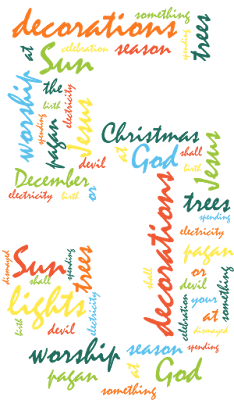 No one can deny that everything looks better decorated and lit up. With early
sunsets and long, dark nights, Christmas lights seem like the perfect way to
spruce up the evenings. How did this trend get started though?
No one can deny that everything looks better decorated and lit up. With early
sunsets and long, dark nights, Christmas lights seem like the perfect way to
spruce up the evenings. How did this trend get started though?
On the 5th Day of Christmas, People Decided To Make Their Own Light
Introduction
The Christmas holiday is known for decorations. Lights adorn trees, garland adorns fences, and other types of decoration fill yards. My family used to drive around the week of Christmas to see everyone's decorations. Half of the excitement was deciding what decorations to put up and convincing my mom to let us string more lights. The sight of otherwise bare trees dolled up in lights was something I looked forward to as the days got shorter and the land starts to look barren... As I dove deeper into my faith and delve deeper into the traditions of Christmas, I realized why this lull is so dangerous spiritually.
The Links To Pagan Sun Worship
The winter is depressing. So many people are depressed during the winter that scientists have named a disorder, Seasonal Affective Disorder, that explains a sensitivity to the lack of light that occurs during the season.[2]
Now, with this in consideration, it's not shocking that people would worship the sun—the warm sunny days of the summer are bright, while the dark dreary days of the winter are more morbid. As such, a celebration of the winter solstice was bound to develop. The winter solstice signifies the shortest day of the year, thus marking the lengthening of the days and the shortening of the darkness (at least in the Northern Hemisphere).[1]
As such, this was celebrated with candles and light (they didn't have light bulbs or electricity back then). The sight of these lights reminded sun-worshipers of the coming sunlight—a rebirth of the sun, if you will—and made them content. They countered the dreariness of the season with feasts and festivities. Today, we still do the same.
As a person who is undiagnosed, but likely suffers from Seasonal Affective Disorder, I completely see the connection of the lights and decorations lifting your mood. The devil knows our weaknesses, and he wants to exploit them for his war against God. He sees that we get a little anxious and down doing the winter, so he dangles false glimmers of hope before us to distract us from the real Light of our world.
Then spake Jesus again unto them, saying, I am the light of the world: he that followeth me shall not walk in darkness, but shall have the light of life.
John 8:12
Thus saith the Lord, Learn not the way of the heathen, and be not dismayed at the signs of heaven; for the heathen are dismayed at them.
Jeremiah 10:2 KJV
Christmas trees, decorations, and lights are all distractions that remain from the pagan holidays like Saturnalia and Yule.
The evidence of our participation in the pagan sun festivities instead of the birth of Jesus as we claim, is that we put up lights and begin decorating before December 25—note that the winter solstice is usually between December 21-23. We take the decorations down right after December 25. Doesn't this seem backwards? A true celebration of Jesus would begin on His birthday and continue a few days after (like the 12 days of Christmas, from the alleged date of His birth to the alleged date of the wise men's arrival—see Day 2: The Origin of December 25). Why would we celebrate His birth beforeHe's born and stop as soon as He's born? Our actions are culminating around the winter solstice, even though our words may be circling Jesus.
As I've mentioned throughout the blog, you have to study to understand God's word and understand His voice, but when you see and hear it, you know that none of the decadence of the season is promoted in the Bible. Not to mention, while you are spending your free time hanging lights and blowing up snowman or spending your extra money on additional electricity usage, you could be doing something for your fellow man, or you could be doing something to strengthen your relationship with God. This is how the devil tricks us. He gets us to think we're doing some thing in the name of God and being good Christians, but really, we're following the devil.
Other Posts in this Series
- The 12 Days of Christmas
- 🔡 Day 1: The Etymology of Christmas
- 📆 Day 2: The Origin of December 25
- 🎅🏻 Day 3: The History of Santa Claus
- 🎁 Day 4: The Tradition of Giving Gifts
- 💡 Day 5: Lights of the Season
- 💥 Day 6: The War on Christmas
- 🎵 Day 7: Carol of the Bells
- 😢 Day 8: Depression and Christmas
- 🎄 Day 9: The Colors of Christmas
- ⛄️ Day 10: Frosty the Snowman & Co.
- 🇺🇸 Day 11: When Christmas as Un-American
- 🤔 Day 12: The True Meaning of Christmas
References
- Byrd, Deborah. "Everything you need to know: December solstice 2015". EarthSky. December 2015
- Garrard, Cathy. "Surprising Causes of Winter Depression". CNN. December 2013




0 Comments:
Post a Comment